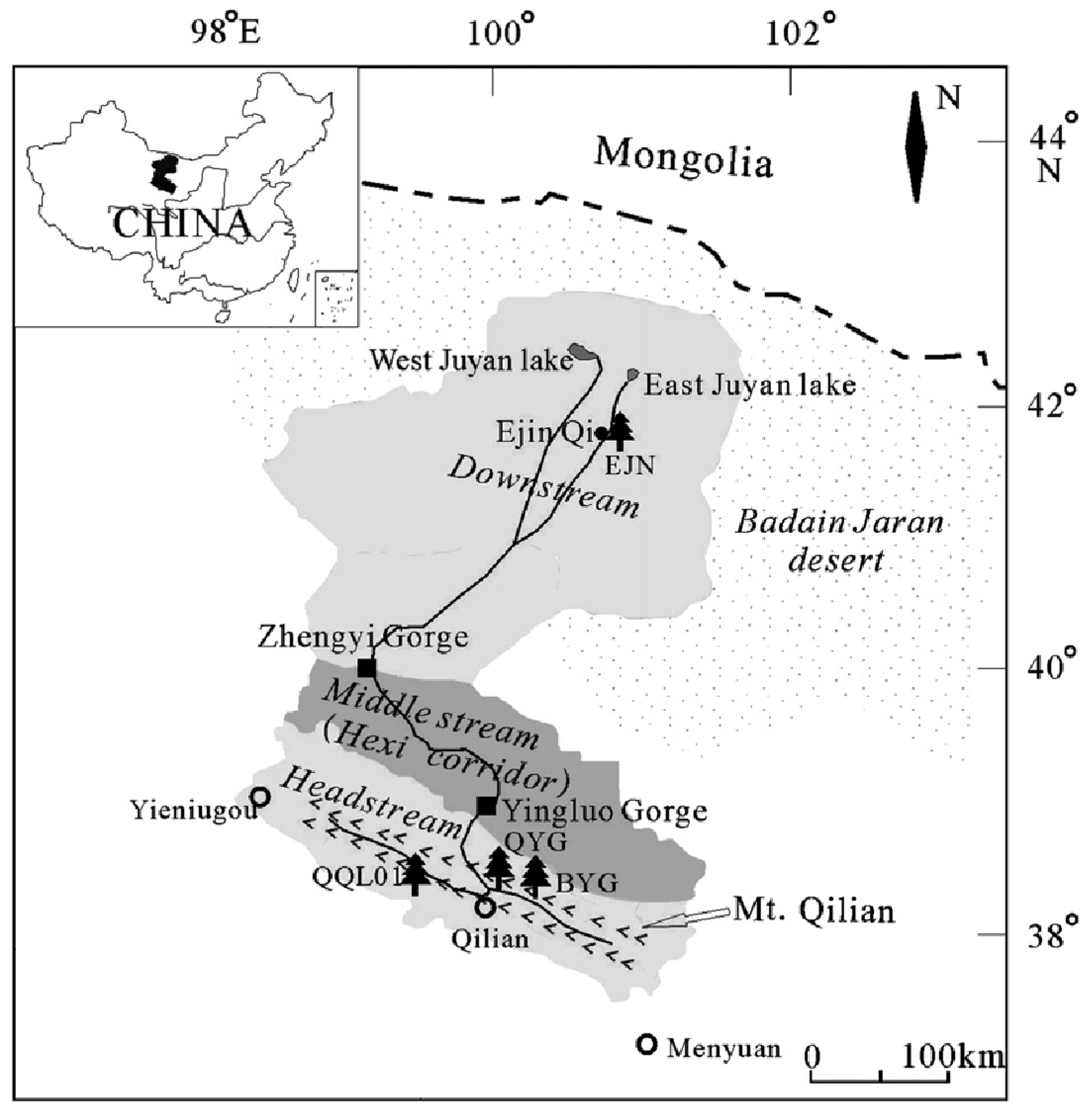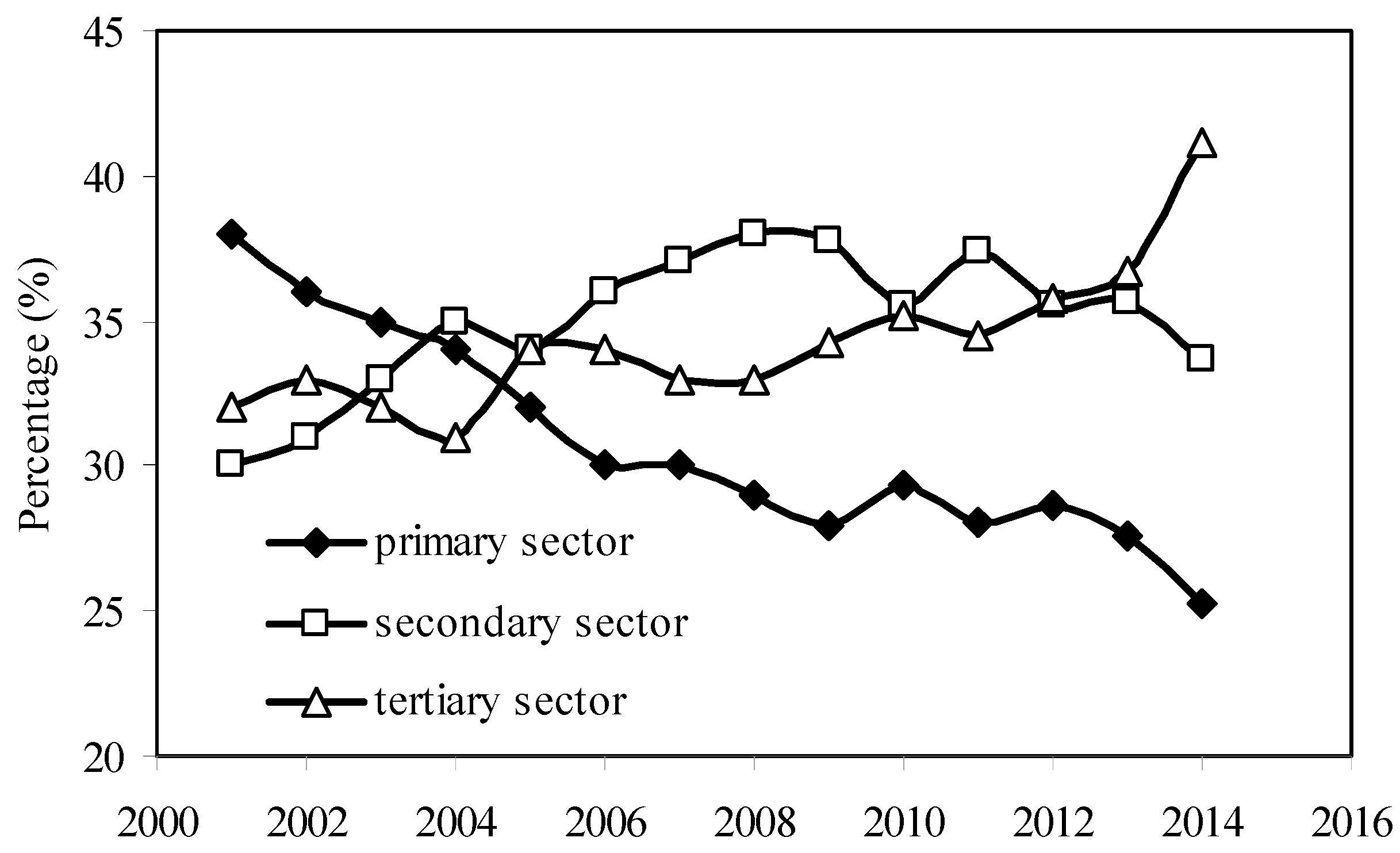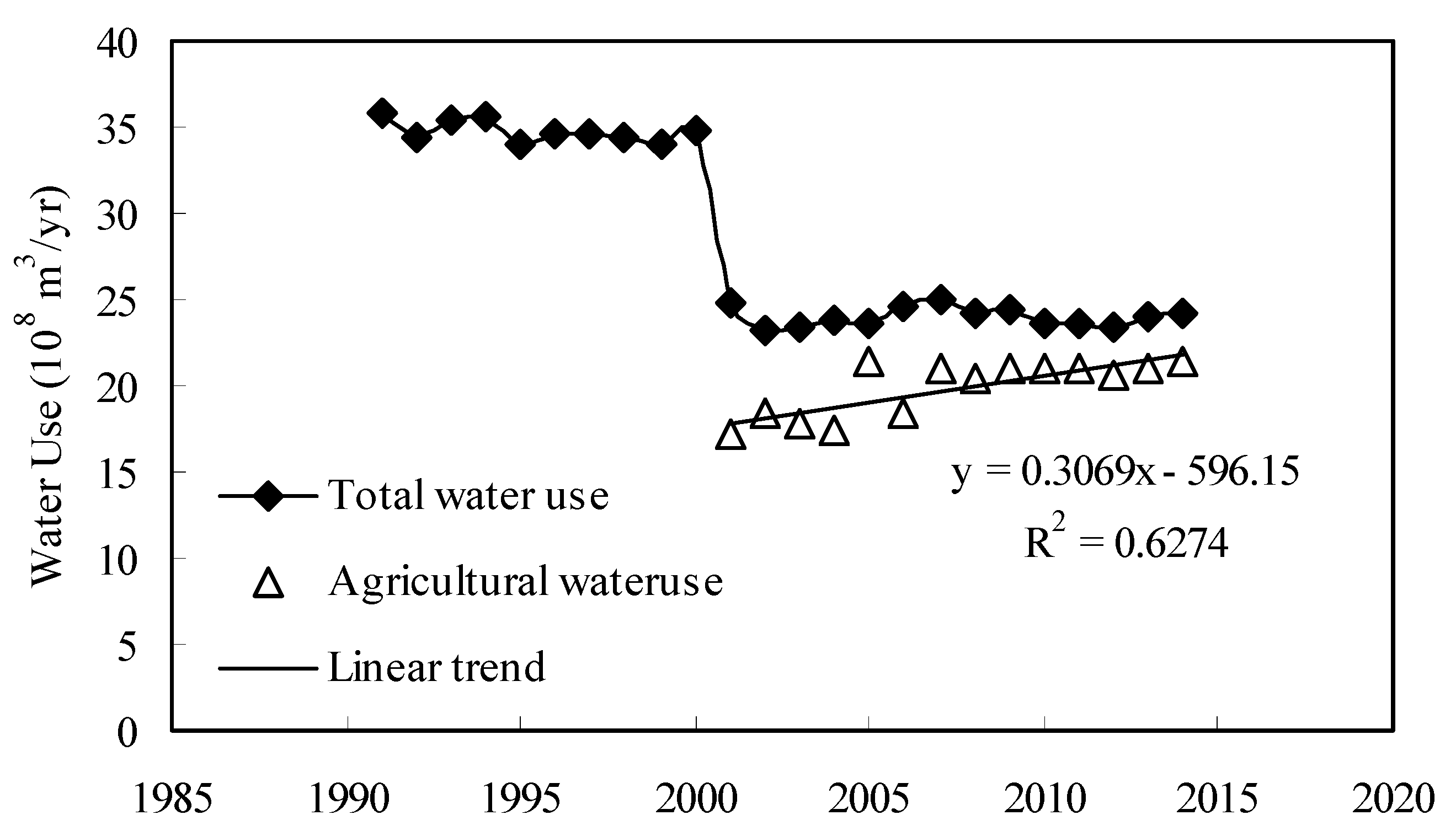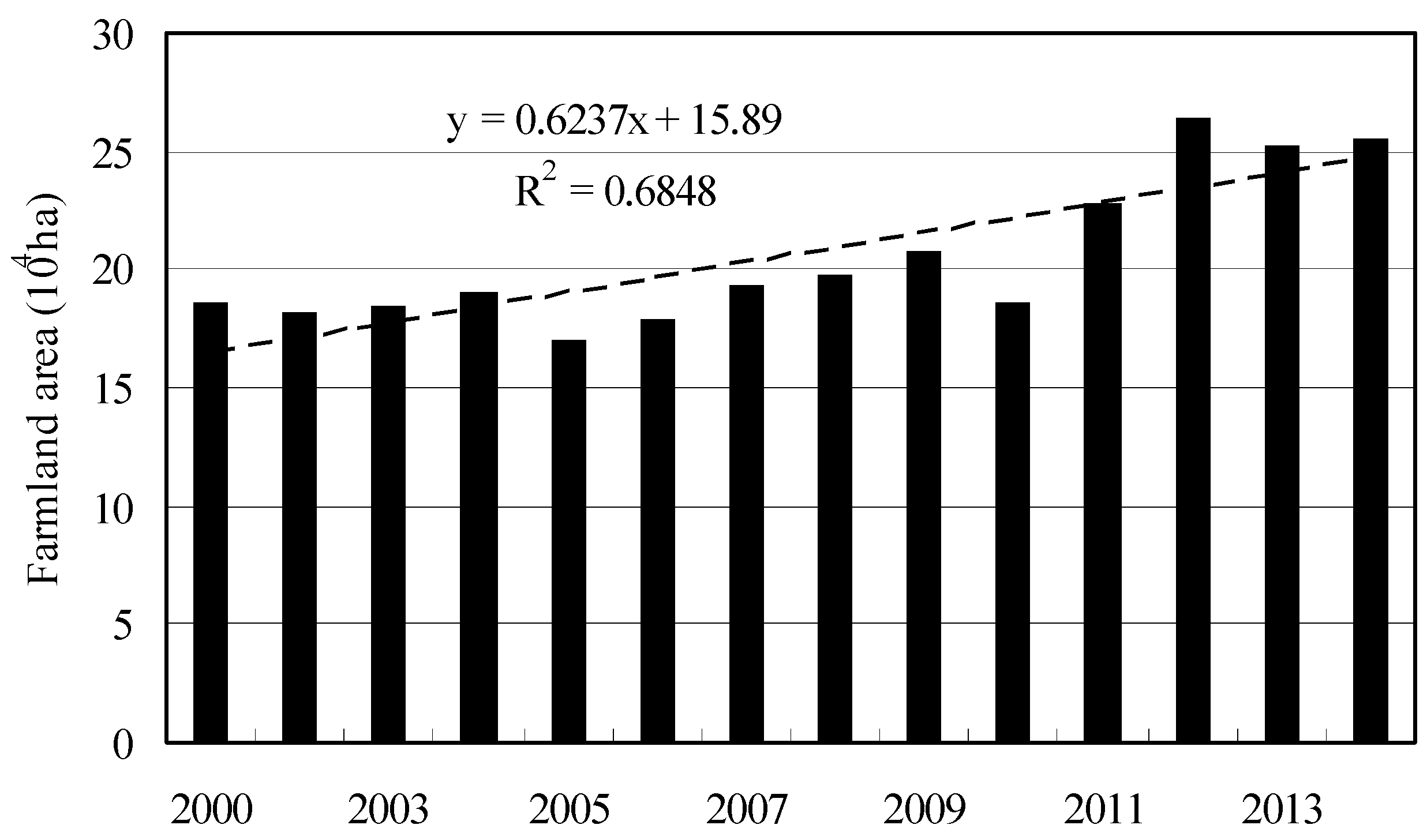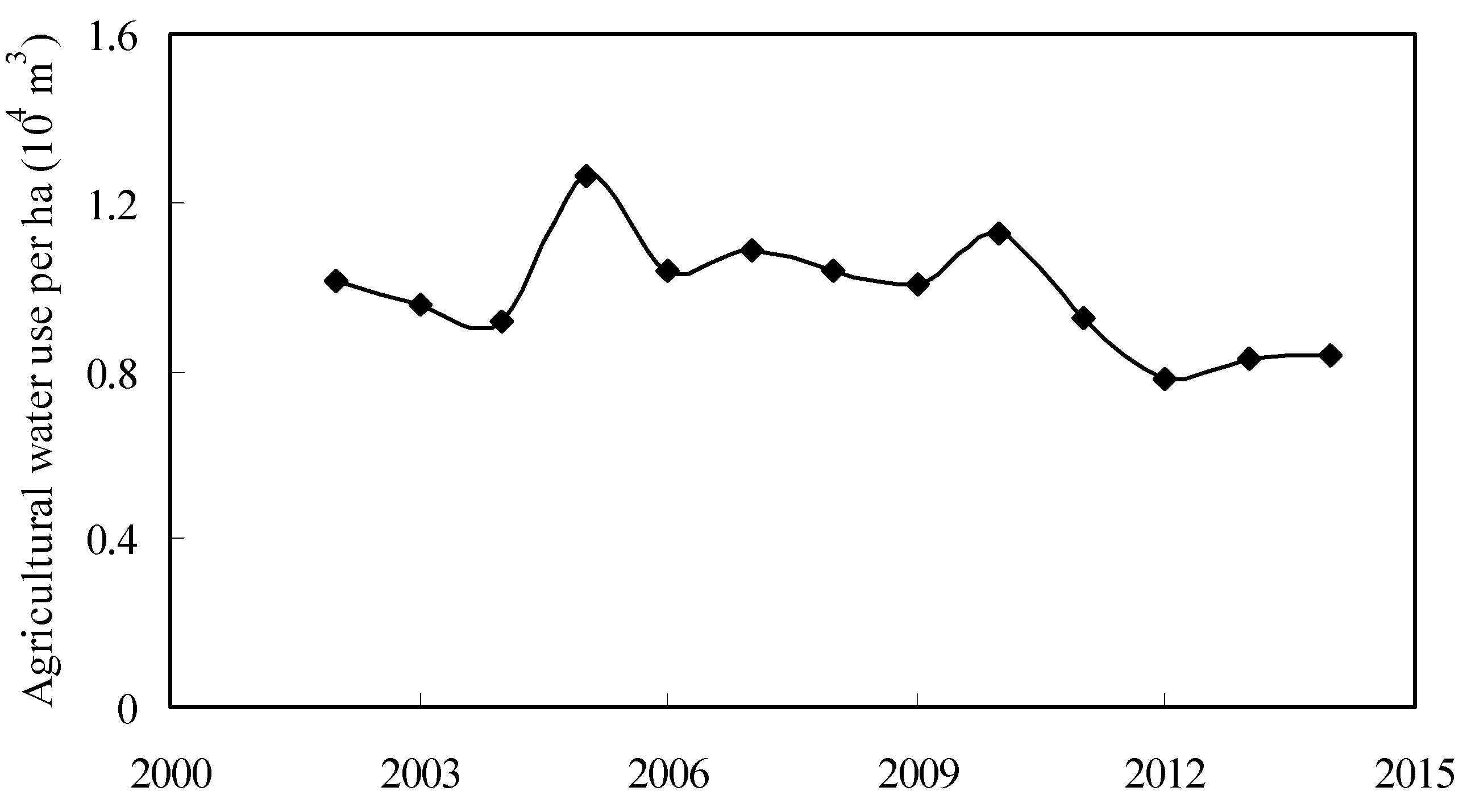4.1. Effects on Society
To coordinate the water allocation, the Heihe River Basin Administrative Bureau (HRBAB) was set up in January 2000 to serve as the main agency for integrated water resource management across the Heihe River Basin and to be responsible for the implementation, operation, and maintenance of large-scale water projects. A water-saving leadership office was also set up in Zhangye City; this office is responsible for planning and implementing various water-saving measures in its jurisdiction.
Since 2002, Zhangye City has established over 20 water-related regulations and guidelines, such as water-saving management regulations, agricultural water trading guidelines, industrial sector water-saving guidelines, water consumption rations for industry, and agricultural and ecosystem water use guidelines. These form the legal foundation for water-saving society construction.
A cornerstone in improving water management in the region was the introduction of a WUR system. Under this system, every farm household is given a water quota depending on the size of the irrigated farmland according to the water consumption ratio stipulated by the water management bureau in Zhangye City. Before 2000, water conflicts over water use occurred almost every year and even resulted in deaths and severe injuries. Since the establishment of the WUR, the number of water conflicts has reduced by more than 70% according to the water-saving leadership office.
Effective public participation is a key factor in the successful implementation of the Building a Water-Saving Society project. The revision of the “Water Law” in China in 2002 provided the public with an institutional guarantee in terms of participation in water resource management. Driven by this law, the Water User Association (WUA) system was established in the Zhangye Basin in 2002 to ensure public participation for better water resource management. Currently, the region has 768 WUAs, which are responsible for arranging water allocations to its member households. Through the WUAs, households apply for and obtain water tickets from the irrigation district offices according to the amount of water a household is entitled to in a particular year. Households can trade their water tickets with other households provided the price charged does not exceed a pre-determined ceiling. With such public involvement, irrigation water volume, irrigation duration, and irrigation areas for all users become transparent.
In the Liushuzhai village, the establishment of water user rights and the operation of the WUA led to water conservation of 750 m3/ha, with a corresponding cost savings of 75 RMB/ha. In the Pengzhuan village, the total water trade volume was 10,000 m3/year, which not only provided irrigation to all the farms in the village but also resulted in water saving of 100,000 m3 and a cost reduction of 10,000 RMB according to information provided by the Zhangye Water Management Bureau.
The Zhangye City government also invested in irrigation channel linings and promoted the use of advanced irrigation techniques, such as sprinklers and drip irrigation. By lining the channels with concrete, water delivery efficiency increased from 50%–70% to 80%–95% [
25].
Following all the measures mentioned above, irrigation water use per unit area decreased by 15% and productivity per cubic meter of water increased by 14% compared with the amounts in 2000, according to Zhangye City statistics.
According to the Zhangye Agricultural Bureau, water-saving irrigation techniques, such as sprinklers and drip irrigation, have now been applied to over 10,000 ha of farmlands in the Zhangye Basin, resulting in saving 1.69 × 108 m3 of water per year.
In August 2014, a household survey was conducted to investigate the level of recognition of the WUA by farmers. For crosschecking, two teams independently conducted the survey at the same time in eight villages located in four irrigation districts (one groundwater irrigation district and three surface-water irrigation districts). The most basic question asked by the two teams was “Do you know the WUA?” Team 1 interviewed 72 households; of those, 68 said they had never heard of the WUA. Team 2 interviewed 83 households. In the surface-water irrigated districts, 25% of the interviewees were aware of the WUA, whereas in the groundwater irrigated areas, 0% of the interviewees knew of such an organization. Nevertheless, in the groundwater irrigated areas, farmers actively participated in water resource management by paying water fees, attending various meetings on irrigation and water-related issues organized by the village or their group, and following the irrigation schedule determined at these meetings. When the farmers were asked where they got their water quotas, those who did not know of the WUA answered that these were given by the village committee or the irrigation water supply office under the water management bureau.
It is common for WUAs to be non-governmental, non-profit organizations. Membership in the WUA is based on contracts and/or agreements between the members and the WUA. However, we found that the representatives and executives of the WUAs we interviewed were either village committee heads or village cadres. Therefore, the WUAs in Zhangye City may be viewed as non-governmental, non-profit organizations with Chinese characteristics. This mixed form of operations may be the reason for the low awareness of the WUA; the village head or cadre is a government position, while the WUA representative is not. Under the current political and cultural environment in China, a person would prefer to use the authority of the village head to forge consensus rather than negotiate with farmers as a WUA representative. As a result, farmers developed the impression that water allocation was determined through the village committee. The underlying issues are a lack of legal development to empower the WUA and a lack of training programs to train farmers to become WUA leaders.
Despite these problems with the WUA in the region, 100% of the interviewees in the surface-water irrigated areas and 92% in the groundwater-irrigated area answered “Yes” when asked if their water use needs were being met by the current water supply management. Another finding worth further investigation is that only 15% of the interviewees knew Zhangye City was a pilot city for building a water-saving society.
True public participation requires the involvement of all stakeholders for decision-making. In the case of Zhangye City, industries, urban residents and private businesses are also concerned parties in water resources utilization and management. However, the current WUA framework is rural-focused and farmer-centered without involving business sector and urban communities although business development and lifestyle change in urban areas will definitely affect water availability in this region. Therefore, what should be pursued for better public participation for water resources management in Zhangye City is to improve the level of farmer’s participation from informing to partnership and to involve other stakeholders at the same time. The vision is to develop a new WUA, transcending the boundaries between rural and urban, agriculture and industry, and public and private.
4.2. Effect on Environment
4.2.1. Wetland Conservation in the Middle Reaches
Over the past several decades, the wetlands in the Zhangye Basin have become seriously degraded due to agricultural development, population growth, effluent discharge from households and industries, and overexploitation of groundwater. In the 1990s, 1300 ha of wetland were reclaimed for farming. The northern suburban reed wetland of Zhangye City shrunk from 597 ha to 522 ha. The mean height of the reeds decreased from 4 m to 2–3 m, and the density decreased by 20%. The diameter of the reeds was 4% thinner [
26]. The total wetland area had reduced by 40% before the new wetland protection policy was implemented.
As part of the integrated water resources management following the water allocation, Zhangye City emphasized wetland restoration and conservation. In 2006, the Zhangye Municipal Government approved the Zhangye Heihe River Basin Wetland Management Regulation. This regulation stipulated that wetland reclamation and the conversion of the water body to farmland be strictly prohibited within the designated wetland area. Furthermore, through a comprehensive conservation plan, the city obtained the approval from the central government to establish the Heihe Wetland National Nature Reserve, which consists of a core zone, a buffer zone, and an experimental zone. Within the core zone, 170 ha of cultivated farmland were converted back to wetland. With the new policy taking effect, the total wetland area in the Zhangye Basin had increased by 8.4% in 2010 compared to 2005, and the total biomass increased by 28.9% [
27]. Currently, the total wetland area is 251,348 ha, which accounts for 6% of the land surface in Zhangye City.
4.2.2. Recovery of Downstream Environment
As water consumption in the middle reaches increased, the ecosystem downstream became seriously degraded. The vegetation area decreased from 6.0 × 10
4 ha in the 1930s to 2.67 in the 1990s. From 1992 to 2000, the oasis area downstream decreased at an annual rate of 6.7%. The predominant natural vegetation in the oasis includes
P. euphratica,
T. ramosissima,
H. ammodendron, and
S. alopecuroides. These species play an important role in maintaining the ecosystem function in this arid area because of their tolerance to severe drought, high salinity, and alkalinity in soils. Vegetation degradation was mainly related to the reduced recharging of riparian groundwater, a decreased groundwater table, and increased salinity in the groundwater system. After the water allocation was implemented, the groundwater table fluctuated significantly in most of the study area with spatial heterogeneity. Generally, the groundwater table rose by 0.5 m in the upper part and 1.5 m in the lower part of the downstream reaches [
28,
29].
As the groundwater table recovered due to water diversion, vegetation deterioration in the lower reaches ceased, and the mean growing season (the previous November–October) fractional vegetation cover (the fraction of soil that is covered by vegetation) increased from 3.4% in 2000 to 4.5% in 2012 [
30,
31]. The most remarkable environmental improvement in the lower reaches was the revival of one of the terminal lakes, East Juyanhai, which dried up in 1992 but now has a surface area of more than 40 km
2 [
32].
Up to the beginning of the 1960s the Aral Sea in the middle of the Kyzylkum Desert was the fourth largest inland lake on earth. Today, much of it dried up due to poor water resources management. Many approaches to solve the Aral Sea problem have been proposed by various groups, individuals, or agencies [
33], but it remains a devastated water body. Compared to the Aral Sea, the recovery of the East Juyanhai is a great story of policy success and may serve as a model to inspire environmental restoration activities for lakes suffering from drying-up.
In economics, externalities are defined as third-party (or spill-over) effects arising from the production and/or consumption of goods and services for which no appropriate compensation is paid. Following this concept, the expansion of agricultural activities in the middle reaches created negative externalities not only in the middle reaches but also downstream. Although the water allocation policy now internalizes the externality downstream, the question of whether the middle reaches should compensate the downstream reaches for the environmental degradation and pay for the cost of restoration remains unexplored.
What the policy did not influence directly upon is chemical fertilizer use. According to previous studies, the total amount of nitrogen fertilizers applied on corn fields in the Zhangye Basin was more than 450 kg/ha/year in recent years [
34]. A study by Yang and Liu [
35] showed that 32.4% of the groundwater well samples in Zhangye had nitrate–nitrogen concentrations exceeding the allowed value set by the WHO. Besides, due to water scarcity, some villages have been using wastewater for irrigation. Owing to the overuse of fertilizer and insufficiently-treated wastewater, seed corns and various vegetables grown in the region were found to contain excessive nitrate [
36].
4.2.3. Impact on Economy
Before the water allocation implementation, the GDP generated per m3 of water in Zhangye City was 2.81 RMB, lower than the national average, and the water consumption for 10,000 RMB GDP was four times the national average. This low water productivity was mainly due to the economic structure. Considering that agricultural water use accounts for 90% of the total water consumption in Zhangye City, the water productivity for wheat, maize, and beans was less than the national average; therefore, optimizing the economic structure from a water productivity perspective was an extremely important step toward regional sustainability. It was believed by the local government that the structural shift from the primary sector-dominated to the second or tertiary sector-dominated economy would result in significant water savings and the water allocation policy can serve as a driver for the optimization. Since 2000, Zhangye City has pursued economic structural adjustment through two initiatives: adjusting the crop structure by replacing crops that have high water use with crops that are less water demanding and adjusting the primary, secondary, and tertiary sector ratios.
As an important step in implementing the WUR, the local government promoted planting water efficient crops and prohibited rice production because of its high water demand. Today, the dominant crop in the Zhangye Basin has shifted from wheat–maize intercropping to seed corn, which accounts for over 25% of the total planting area in the basin. As far as income per hectare is concerned, intercropping is better than seed corn. However, water consumption for intercropping is about 40% higher than that of seed corn, which was the reason for the shift. Nevertheless, in terms of water consumption, wheat is about 30% less demanding than seed corn in the Zhangye Basin [
37,
38], but it was not promoted as a water-saving measure because of its lower yield and market value compared to seed corn. This factor indicates that the strategy employed in building a water-saving society was to not only maximize water conservation but also strike a balance between water conservation and helping farmers improve their profitability.
With the implementation of the two initiatives, the ratio of grain to cash crops changed from 67:33 in 2001 to 44:55 in 2007, and the water productivity or GDP generated per m3 of water increased to 8.9 RMB in 2013.
Figure 2 shows the changes in the economic structure in terms of GDP from 2001 to 2014. The tertiary sector has expanded from 32% to 41%, while the share of the primary sector has decreased from 38% to 25%.
Figure 2.
Changes of sectoral shares in term of GDP.
Figure 2.
Changes of sectoral shares in term of GDP.
Figure 3 shows the variations in the annual total water use in Zhangye City from 1991 to 2014. It is clear that a large reduction in water use occurred before and after the policy intervention. The application of the Mann–Kendall test to the water-use dataset confirmed a statistically significant reduction, which is due to the water allocation policy. To see how the total water use was affected by the economic structural adjustment, a correlation analysis was conducted using data from 2001. The analysis indicated that the ratio of the primary sector to the secondary and tertiary sectors was not correlated with variations in water use from 2001 to 2014, implying that the economic structural adjustment did not lead to further reductions in water use in Zhangye City. Furthermore, a change-point analysis, which is an effective and powerful statistical tool for detecting mean shifts in a time series [
39], was employed to discover any subtle turning points in water use since 2001. The change-point analysis detected no turning points in water use since 2001. Examining details of water uses showed that agricultural water use had an increasing trend (
Figure 3). The change-point analysis detected a turning point for agricultural water use in 2005 with a confidence level of 95%. A further probe into this matter found that agricultural land expansion did not end with the water allocation policy.
As shown in
Figure 4, the total crop area increased from 18.67 × 10
4 ha in 2000 to 25.94 × 10
4 ha in 2014. This was in violation of the principle of prohibiting more farmland development, which was set up as part of the water saving society-building process in Zhangye City. Despite the violation, whether it led to a decrease in water use efficiency in the agricultural sector should be examined. Although the change in annual agricultural water use from 2001 to 2014 has an increasing trend, as seen in
Figure 3, when divided by the total cultivation area, the agricultural water use per unit farmland appears not to have increased, as depicted in
Figure 5. Indeed, the application change-point analysis on the data revealed a turning point in 2010, after which time the agricultural water use per unit area decreased. Considering that the GDP per m
3 of water increased from 2.8 RMB in 2000 to 8.9 RMB in 2013, it may be asserted that the current situation shows a good balance between water conservation and economic development.
Figure 3.
Changes of total and agricultural water uses in Zhangye City.
Figure 3.
Changes of total and agricultural water uses in Zhangye City.
Figure 4.
Arable land change in Zhangye City since 2000.
Figure 4.
Arable land change in Zhangye City since 2000.
Figure 5.
Variation of agricultural water use per unit cultivated land.
Figure 5.
Variation of agricultural water use per unit cultivated land.
Simulations by Wu [
8], who used the CGE approach for Zhangye City, showed a considerable water-saving benefit from industrial transformation when the output value of secondary and tertiary industries increases and the contribution of the planting sector to the total output value decreases. The present study demonstrated that the model prediction has not yet been realized. This serves as evidence that more actual data-based case studies should be conducted.
4.2.4. A New Dimension
On 28 March 2015, China’s top economic planning agency, the National Development and Reform Commission, and the Ministries of Foreign Affairs and Commerce, jointly released a new action plan outlining key details of Beijing’s “One Belt, One Road” initiative. Initially planned as a network of regional infrastructure projects, this latest release indicates that the scope of the “Belt and Road” initiative has expanded to become a centerpiece of both China’s foreign policy and domestic economic strategy. This initiative will include financial integration, trade liberalization, and people-to-people connectivity across the Asian continent. Since the “Belt” will run through Zhangye City, it could provide great economic stimulus to the city, which would lead to significant economic structural shift, possibly affecting water resources management in many ways. Therefore, the sustainability of Zhangye City will largely depend on the sustainability of the “One Belt, One Road” policy and the prosperity of a much larger region in the long term.
